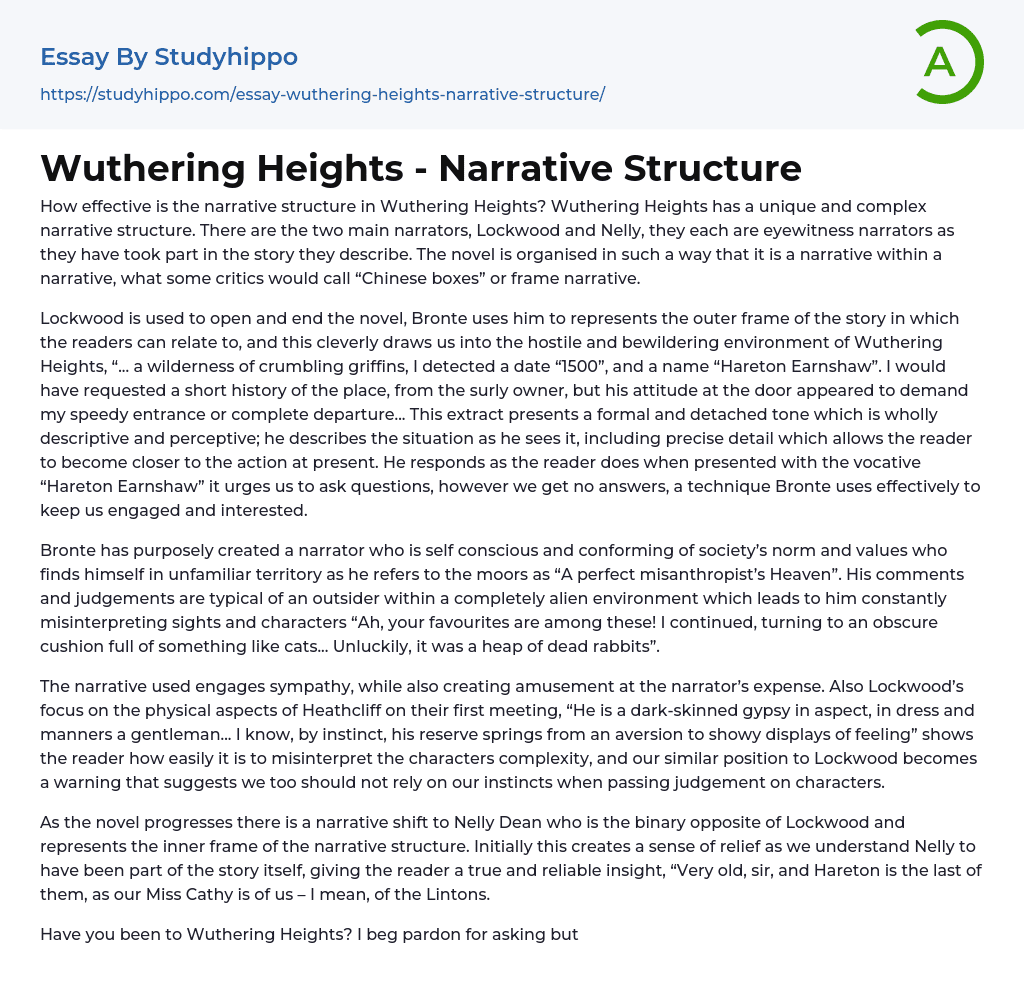What is the efficacy of the narrative structure in Wuthering Heights? The structure of the narrative in Wuthering Heights stands out for its uniqueness and complexity. The primary narrators are Lockwood and Nelly, both of whom can be categorized as eyewitness narrators since they are participants in the events being recounted. The book is structured as a "Chinese boxes" or frame narrative, which refers to a narrative within another narrative, a style some critics have recognized.
In the novel, Lockwood is utilized to commence and close the story. Bronte effectively uses his character to exemplify the outer narrative framework that the readers can connect to. This strategy skillfully immerses us into the intimidating and perplexing atmosphere of Wuthering Heights, "...a wasteland of decaying griffins, I spotted a date "1500", and a name "Hareton Earnshaw". I would have asked for a
...brief history of the estate, from its grumpy proprietor, but his demeanor at the entrance seemed to call for my immediate entry or abrupt exit ... This excerpt expresses an official and impartial tone that is purely descriptive and insightful. He narrates the situation from his perspective, incorporating meticulous details that allows the audience to be more intimately involved with the ongoing happenings. He reacts just like readers do when confronted with the stand-alone phrase "Hareton Earnshaw". This provokes us to seek clarification, despite us not receiving any, a strategy that Bronte aptly employs to maintain our intrigue and engagement.
Bronte intentionally crafted a storyteller who is self-aware and abides by societal norms and beliefs, but feels out of place as he equates the moors to "A perfect misanthropist’s Heaven". His observations and assessments are characteristic of
someone unfamiliar with their surroundings, which often results in him misunderstanding what he sees and the characters he meets. An example is when he mistook a pile of dead rabbits for cats, saying "Ah, your favourites are among these! I continued, turning to an obscure cushion full of something like cats... Unluckily, it was a heap of dead rabbits".
The storytelling approach induces empathy and simultaneously provides humor at the expense of the narrator. In addition, Lockwood's attention to Heathcliff's physical characteristics during their inaugural meeting, "He is a dark-skinned gypsy in aspect, in dress and manners a gentleman... I know, by instinct, his reserve springs from an aversion to showy displays of feeling," indicates to the reader the ease with which one can misconstrue the depth of the characters. This also serves as a cautionary tale, hinting we should also be careful not to depend solely on our intuition when evaluating personas.
The novel undergoes a change in narrative direction towards Nelly Dean, who stands as the polar opposite of Lockwood, embodying the internal framework of the story's structure. This initially results in a feeling of respite as we comprehend Nelly as an integral part of the plot itself, providing the reader with an accurate and trustworthy perspective, “Very old, sir, and Hareton is the last of them, as our Miss Cathy is of us – I mean, of the Lintons.
Did you ever pay a visit to Wuthering Heights? Excuse my curiosity, I am keen on finding out about her wellbeing." Nonetheless, the employment of possessive and collective pronouns like "our" and "us" outlines her emotional attachment with the characters. Additionally, her self-correction underlines her unclear
perception of her identity and the family to which she belongs. This insinuates that she shares a common trait with Lockwood: unreliability.
Indeed, Nelly Dean's function as a trusted friend to nearly every character in the narrative grants her a considerable degree of authority. From a feminist perspective, she is the most powerful because she possesses the capability to shape and steer the narrative. Yet, Bronte's use of an epistolary structure reveals female vulnerability, as disclosed in Isabella's dissatisfaction in her marriage, divulged in a confidential letter to Nelly. The letter starts with "Dear Ellen, I have to write to someone, and the only one available is you..."
Does Mr. Heathcliff qualify as a human? If affirmative, could he be insane? Conversely, is he a demon? The repetitive invocation of questions incites feelings of anxiety and immediacy, a clear indication of Isabella's urgent need to convey her terrified and remorseful state. The narrative uniquely reflects Bronte's viewpoint as it ingeniously uses this letter to condemn societal norms regarding matrimony. It discreetly sheds light on the harsh truth of Isabella's status as an abused spouse.
- Book Summary essays
- Metaphor essays
- Reader essays
- Rhyme essays
- Literary devices essays
- Villain essays
- Books essays
- Genre essays
- Literary Criticism essays
- Writer essays
- Protagonist essays
- Simile essays
- Poem essays
- Book Report essays
- Book Review essays
- Greek Mythology essays
- Plot essays
- Tragic Hero essays
- Coming of Age essays
- Play essays
- Rhetoric essays
- Rhetorical Question essays
- Translation essays
- Understanding essays
- Reason essays
- Character essays
- Letter essays
- American Literature essays
- Literature Review essays
- Utopia essays
- Poetry Analysis essays
- Dante's Inferno essays
- Between The World and Me essays
- Incidents in The Life of a Slave Girl essays
- Flowers for Algernon essays
- Myth essays
- Everyday Use essays
- Boo Radley essays
- Genesis essays
- Richard iii essays
- Alice in Wonderland essays
- On the road essays
- Ozymandias essays
- The Nightingale essays
- Holden Caulfield essays
- Animal Farm essays
- 1984 essays
- A Hanging essays
- Shooting An Elephant essays
- A Tale Of Two Cities essays




